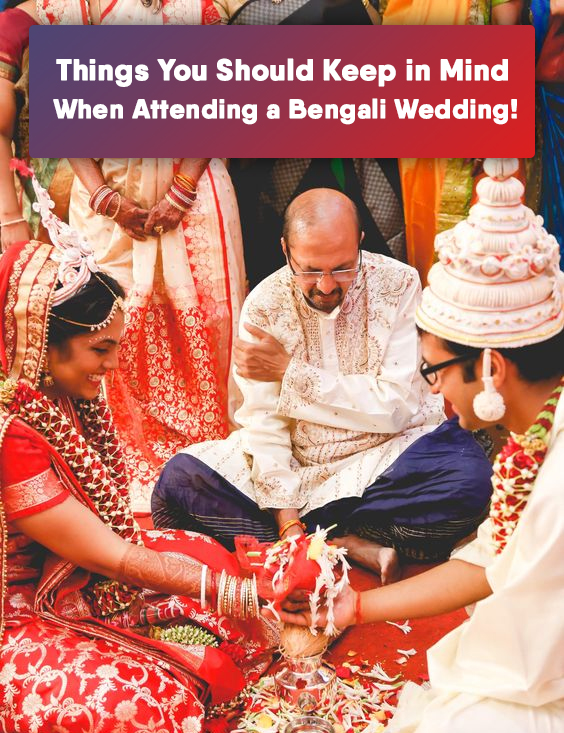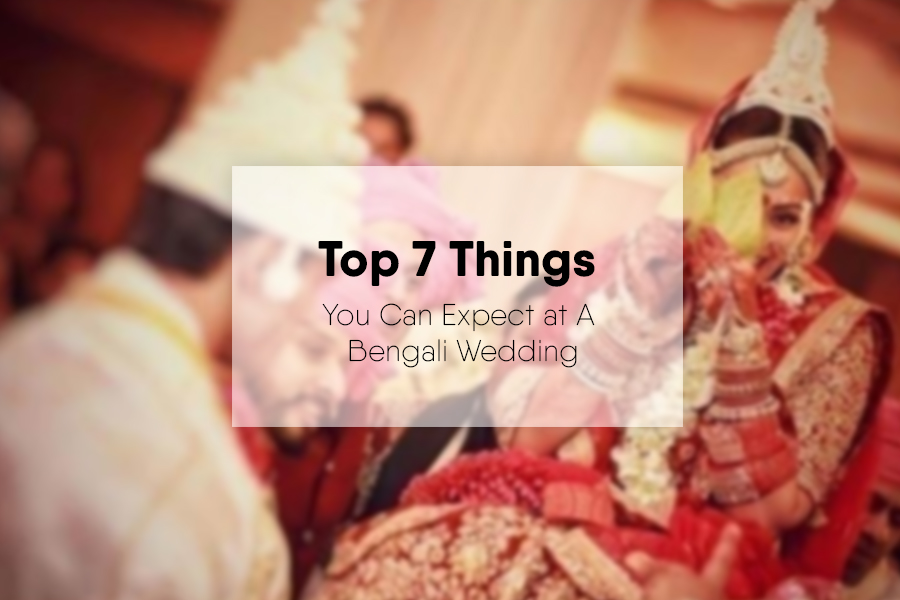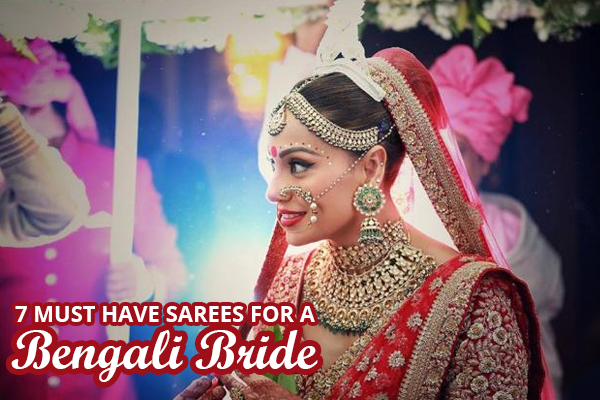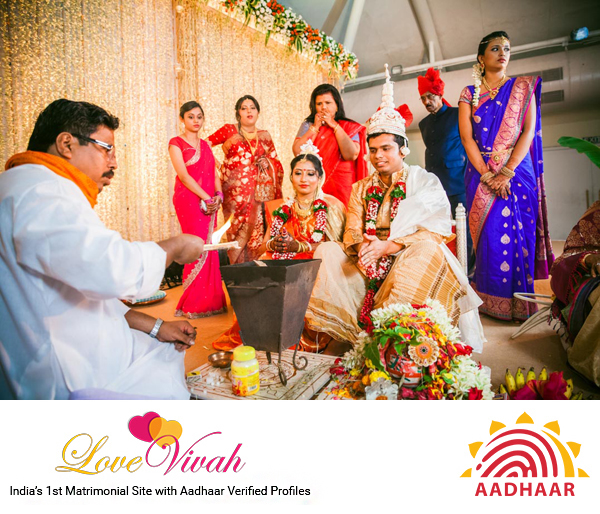Traditional Indian Weddings are not just gorgeous, lavish and full of fun, but also culturally rich and diverse. Every distinct Indian community wedding is a sight to behold and an experience to drown oneself in. And so is the Bengali wedding!
Traditional Bengali weddings are unique in their customs, flavors, attires, food, and rituals – very different from almost all the other parts of India.
There are numerous unique nuances that one must not miss experiencing in a Bengali wedding in order to fully enjoy this authentic experience. Each set of ceremonies are important to watch out for, beginning with Aaiburo Bhaat, (the last meal as a bachelor/spinster), Gaye Holud (Haldi ceremony) and the actual wedding ritual, thereafter the Bashor Ghor.
So, here are a few things to keep in mind and to look out for and experience, when attending a Bengali marriage!
The Bachelorette Feast (Aiburo Bhaat)
A day before the wedding, a grand feast is offered for the bride-to-be and the groom-to-be in their respective homes by their respective families. This meal marks the last day of their lives as an unmarried man and woman. This is a fun feast with friends and family joining in the celebration of the couple’s end of singlehood and moving into Bengali Matrimony.
The Unique Wedding Attire
Bengali wedding attire is very different from most of the other Indian wedding attires, both in the case of the bride and the groom. Through centuries, the traditional Bengali bride wears a typical red (or any other auspicious color) authentic Banarasi sari and a Red Cheli (Veil) for her wedding day. She is also adorned in a unique, triangular and intricately carved headgear called Mukut made of Shola (a milky white sponge). Likewise, the groom’s headgear is called Topor, which is conical and equally intricately designed, which is gifted to him by the bride’s side. He wears it during the wedding ceremonies along with his traditional Bengali Dhoti and Kurta. A traditional Bengali bride and groom are a gorgeous sight to behold!
For good luck, besides the Mukut and the Topor as headgears, the couple must also carry two distinct items in their hand during the wedding ceremonies. The groom is given the Jaanti, a traditional betel nut cracker to hold, while the bride is given the gach kouto (a red, tall container) to keep in her hand all the while as they take their marriage vows. These items are traditionally considered to be auspicious and helpful to ward off bad luck. These are the two unique items to look out for in an authentic Bengali wedding.
The Thrilling Shubhodrishti Lift Up in The Air
One of the most famous Bengali wedding rituals is the Saat Paak or the seven circumventing which the bride is made to take around the groom just before Shubhodrishti (meeting of the couple’s eyes). In this famous ritual, often depicted in movies that show a Bengali wedding, the brothers/cousin brothers carry the bride while she is made to seat on a Piri (wooden plank). This wooden plank is lifted up in the air from all sides by her brothers, and the bride is carried around the groom seven times. Then, the couple is brought face to face, and they finally look at each other for the first time during the day, known as Shubhodrishti (auspicious glance). Then, the couple exchange glances and thereafter, floral garlands too.
In this ceremony, another unique custom to look out for is the nuance of the bride covering her face with two green betel leaves all throughout the Saat Paak. She lowers the leaves from her face only after the completion of the seven rounds and at the moment of Shubhodrishti.
The much-dreaded (by most nervous brides) yet most fun game during this ritual is the brothers deliberately lifting the wooden plank much higher than the groom so that he cannot put the garland around her. Likewise, the groom’s friends also lift him up to help him succeed in garlanding and winning his bride. This traditional fun competition between the bride’s side and the groom’s side is also fuelled on by family elders adding in funny and friendly banters from aside. This is one unique fun ritual that you should not miss.
The Beautiful Fire Ritual
Bengali weddings have Kanyadaan (giving away the daughter by the father/uncle), then the Yagna fire is lit, and the entire wedding takes place around the fire as the sacred witness. The bride and groom offer puffed rice offerings to the fire. The smearing of vermilion and Saptapadi takes place around the fire. Saptapadi is the seven steps where the bride pushes the traditional stone pestle with her toe with the groom behind, symbolizing the strength and dedication to keep moving the conjugal and domestic duties ahead no matter how challenging it gets. Also, the couple takes seven rounds around the sacred fire while making seven sacred marital vows. It is a spectacle to behold in a Bengali wedding! These main rites of the evening are exquisitely beautiful to watch and must not be missed.
Unlimited Fun and Frolic
Now you can guess how much the Bengali weddings, like all else, team up with frolic and fun. A large gathering of extended family and friends take part in the wedding procedure that lasts several days. Besides the garland competition, the other extreme fun event is Bashor Ghor. This is the gathering that takes place right after the actual wedding ritual is complete. The night of the wedding, the newlywed couple is not left alone, but heavily flanked by friends and family who sing, recite, play fun games and make merry along with the couple. This is a fun event that one just cannot miss while attending a Bengali wedding, which is filled with laughter, noise, and fun.
Authentic Bengali Food
If you’re attending a traditional Bengali wedding, be sure it will include an elaborate feast including non-vegetarian delicacies. Bengali wedding rituals take place usually at night, and hence, the wedding feast is a hefty and sumptuous dinner. The menu includes rice preparations like Pulav or ghee bhaat (rice cooked in ghee), various vegetarian dishes, but also without fail, a number of non-vegetarian dishes made of fish and meat. If you’re attending a Bengali wedding, gorging on the wedding feast goes without saying! After the dinner, there is a wide range of desserts such as the famous Mishti doi (sweetened curd), rasgoollas, and other sweet meats. At the end, traditional Bengali paan (betel leaf) is offered to every guest.
Altogether, a Bengali wedding is a fun-filled, once-in-a-lifetime experience of unique nuances to look out for. Now that you know what all to keep in mind while attending such an event; go ahead and enjoy to the hilt in any Bengali wedding!




